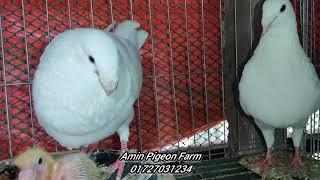In this video, we learn about the common tern.
QUICK FACTS:
• Lifespan: 12 years
• Length: 13 in
• Wingspan: 35 in
• Weight: 4 oz
• Family: Laridae
Description
The common tern is a seabird of the Laridae family that also includes gulls and skimmers. During the breeding season, its plumage is gray above and pale below with a black cap, a white rump, and a white tail. After the breeding season, the upperparts and forehead become white.
The legs are orange-red that become darker in winter, and the bill is red with a black tip or all-back. There are four recognized subspecies usually distinguished by range and bill color.
Vocalizations: call and song
Common terns are known for their harsh, shrill calls. They have a wide vocabulary, including the distinctive keeaah alarm call, the single note kip contact call, and a range of other vocalizations.
Distribution and range
Common terns breed across the temperate and subarctic regions of the northern hemisphere. They are strongly migratory and spend winters in the southern hemisphere along coastlines and in tropical and subtropical regions.
Habitat
During the breeding season, the common tern inhabits islands, beaches dunes, salt marshes, and other open areas near water. During winter, they mostly occur in coastal environments.
Diet and feeding habits
Common terns are predominantly piscivorous, feeding on various species of small fish. They also eat crustaceans, squid, leeches, sea worms, and aquatic insects. Common terns may resort to kleptoparasitism (stealing the prey of other birds).
They are, however, adept hunters with excellent vision. They employ various fishing methods, often hovering above the water surface, circling schools of fish, and plunge-diving or swooping and dipping to catch prey. They may also pick prey near the surface while swimming.
Nesting and breeding
Common terns are monogamous. They typically nest in large colonies, but smaller colonies, and even solitary pairs also occur. They nest in shallow scrapes in the sand often lined with vegetation, rimmed with stones or seashells.
Females typically lay three eggs and the incubation period lasts around 22 days. The chicks are fairly precocial and covered in down but only fledge after three to four weeks. They may be supported by their parents until the end of the breeding season and sometimes longer. Common terns aggressively defend their nests and young.
Status and conservation
The common tern is widespread and common across its range. However, some populations have declined due to habitat destruction, pollution, invasive species, and human disturbance.
They are listed as least concern by the IUCN, but they are protected by the Agreement on the Conservation of African-Eurasian Migratory Waterbirds (AEWA).
#avibirds #bird #birdwatching #commontern #sternahirundo
QUICK FACTS:
• Lifespan: 12 years
• Length: 13 in
• Wingspan: 35 in
• Weight: 4 oz
• Family: Laridae
Description
The common tern is a seabird of the Laridae family that also includes gulls and skimmers. During the breeding season, its plumage is gray above and pale below with a black cap, a white rump, and a white tail. After the breeding season, the upperparts and forehead become white.
The legs are orange-red that become darker in winter, and the bill is red with a black tip or all-back. There are four recognized subspecies usually distinguished by range and bill color.
Vocalizations: call and song
Common terns are known for their harsh, shrill calls. They have a wide vocabulary, including the distinctive keeaah alarm call, the single note kip contact call, and a range of other vocalizations.
Distribution and range
Common terns breed across the temperate and subarctic regions of the northern hemisphere. They are strongly migratory and spend winters in the southern hemisphere along coastlines and in tropical and subtropical regions.
Habitat
During the breeding season, the common tern inhabits islands, beaches dunes, salt marshes, and other open areas near water. During winter, they mostly occur in coastal environments.
Diet and feeding habits
Common terns are predominantly piscivorous, feeding on various species of small fish. They also eat crustaceans, squid, leeches, sea worms, and aquatic insects. Common terns may resort to kleptoparasitism (stealing the prey of other birds).
They are, however, adept hunters with excellent vision. They employ various fishing methods, often hovering above the water surface, circling schools of fish, and plunge-diving or swooping and dipping to catch prey. They may also pick prey near the surface while swimming.
Nesting and breeding
Common terns are monogamous. They typically nest in large colonies, but smaller colonies, and even solitary pairs also occur. They nest in shallow scrapes in the sand often lined with vegetation, rimmed with stones or seashells.
Females typically lay three eggs and the incubation period lasts around 22 days. The chicks are fairly precocial and covered in down but only fledge after three to four weeks. They may be supported by their parents until the end of the breeding season and sometimes longer. Common terns aggressively defend their nests and young.
Status and conservation
The common tern is widespread and common across its range. However, some populations have declined due to habitat destruction, pollution, invasive species, and human disturbance.
They are listed as least concern by the IUCN, but they are protected by the Agreement on the Conservation of African-Eurasian Migratory Waterbirds (AEWA).
#avibirds #bird #birdwatching #commontern #sternahirundo
- Catégories
- Chats de Race Manx
- Mots-clés
- common tern bird, common tern 101, common tern
















Commentaires